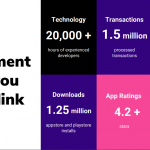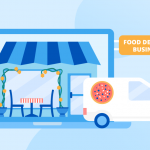In today’s digital age, online ordering for restaurants has become an essential restaurant business component.
With the rise of food delivery apps and the growing demand for convenience, more and more restaurants are embracing online ordering tools to streamline their operations and meet the evolving needs of their customers.
While these tools offer undeniable benefits, restaurant owners must understand the true financial implications they may face in 2023 and beyond.
The Rising Costs of Restaurant Online Ordering Tools
Restaurant online ordering tools, have evolved significantly over the years, providing unprecedented convenience and accessibility for both customers and business owners.
However, with these advancements come rising costs.
The financial burden of implementing and maintaining an online ordering system can quickly accumulate from monthly subscription fees to transaction charges and commission rates.
Moreover, as restaurants increasingly rely on these tools, providers have begun to capitalize on their essential nature, resulting in escalating prices.
Restaurant owners must stay informed about these cost trends and carefully evaluate the financial impact before using an online ordering tool.
One factor contributing to the rising costs of restaurant online ordering tools is the constant need for updates and maintenance.
Software providers must invest in regular updates as technology advances to ensure their platforms remain secure and up-to-date.
These costs are often passed on to the restaurant owners, increasing the financial burden of using these tools.
Additionally, the increasing demand for customization and integration options has also driven up the costs of online ordering tools.
Restaurants now expect these tools to seamlessly integrate with their existing POS systems, inventory management software, and loyalty programs.
Meeting these demands requires additional development and integration work, which can significantly impact the overall cost of the online ordering solution.
True Financial Impact of Online Ordering Tools
When considering the financial impact of online ordering tools, it’s essential to look beyond the direct costs associated with their use.
While subscription fees and commissions are more apparent, additional hidden expenses can significantly impact a restaurant’s bottom line.
These include:
* Integration and setup costs
* Training and support fees
* Menu update charges
* Technical maintenance and upgrades
Restaurant owners need to consider these factors when evaluating the true financial impact of integrating an online ordering tool into their business operations.
One hidden expense that restaurant owners should consider is the cost of marketing and promoting their online ordering platform.
While the tool itself may streamline the ordering process, investing in marketing efforts to drive traffic and increase platform awareness is essential.
This can include online advertising, social media campaigns, and other promotional activities.
Another factor to consider is the potential impact on staffing and labour costs.
Implementing an online ordering tool may require additional staff to manage and fulfil orders, especially during peak times.
This can result in increased labour expenses and the need for additional training and resources to ensure smooth operations.
The Hidden Expenses of Using Restaurant Online Ordering Tools
One of the often-overlooked costs of utilizing restaurant online ordering tools is the impact on overall operational efficiency.
While these tools promise increased efficiency and order accuracy, they can also introduce hidden expenses if not properly implemented or managed.
For instance, if the online ordering tool is not seamlessly integrated with existing POS systems or kitchen workflows, it may lead to extra staff time spent on manual order entry or kitchen miscommunication.
Additionally, customer service-related expenses may arise if issues with the online ordering platform result in dissatisfaction or order errors.
To minimize these hidden costs, restaurant owners should ensure proper training for staff, efficient integration with existing systems, and proactive monitoring of customer feedback to address any issues promptly.
Another potential hidden expense of using restaurant online ordering tools is the cost of maintaining and updating the technology.
As technology evolves, online ordering platforms may require regular updates or replacements to stay current and secure.
This can involve additional expenses for software licenses, hardware upgrades, or hiring IT professionals to manage the system.
Evaluating the Total Cost of Ownership for Your Online Ordering Tool
When considering the financial viability of an online ordering tool, it’s essential to evaluate the total cost of ownership (TCO).
TCO includes the upfront and ongoing expenses associated with the tool’s implementation, maintenance, and usage.
Factors that contribute to the TCO of an online ordering tool include:
* Initial setup costs, including hardware and software investments
* Monthly subscription or licensing fees
* Transaction fees or commission rates
* Integration and customization charges
* Training and support fees
* Marketing and promotional expenses to drive adoption and attract customers
By carefully evaluating the TCO, restaurant owners can make more informed decisions about which online ordering tool best suits their business needs and long-term financial goals.
Another essential factor to consider when evaluating the TCO of an online ordering tool is the solution’s scalability.
As your business grows and your online orders increase, you may need to upgrade your tool or invest in additional resources to handle the higher volume.
This can result in additional costs that should be factored into the TCO analysis.
In addition to financial costs, it’s also crucial to consider the time and effort required to implement and maintain the online ordering tool.
This includes data migration, system integration, and ongoing updates and maintenance.
The more complex the tool, the more resources and expertise may be needed, impacting the overall TCO.
Breaking Down the Financial Consequences of Adopting an Online Ordering System
Adopting an online ordering system undoubtedly brings numerous benefits to a restaurant.
However, it’s equally important to understand and plan for the potential financial consequences that may arise throughout the system’s lifecycle.
One such consequence is the potential cannibalization of profits.
While online ordering can attract new customers and increase sales, it may also result in the transfer of existing in-store orders to online channels.
This shift can impact profit margins, especially considering the additional costs associated with online orders, such as packaging and delivery expenses.
Furthermore, the need for ongoing marketing and promotional efforts to drive online order adoption can strain a restaurant’s financial resources.
It’s essential to carefully analyze the potential financial consequences and develop strategies to mitigate risks and maximize the benefits of an online ordering system.
Another financial consequence when adopting an online ordering system is the initial investment required to set up the system.
This includes the cost of purchasing or developing the software, training staff to use the system, and potentially upgrading hardware or internet infrastructure.
These upfront expenses can strain a restaurant’s budget, especially for small businesses with limited financial resources.
In addition to the initial investment, ongoing maintenance and support costs should also be factored into the financial analysis. Online ordering systems require regular updates, bug fixes, and technical support to ensure smooth operation. These costs can add up over time and should be accounted for in the restaurant’s budget to avoid any unexpected financial burdens.
Uncovering the Unforeseen Expenses Associated with Restaurant Online Ordering Tools
While restaurant owners may meticulously plan for the known costs associated with online ordering tools, it’s essential to anticipate and prepare for unforeseen expenses that may arise during implementation and usage.
Examples of unforeseen expenses may include:
* Technical difficulties requiring additional support or upgrades
* Integration issues with existing systems, necessitating outsourced professional services
* Increased demand for customer service due to platform usability challenges
By setting aside contingency budgets and regularly reviewing the system’s performance, restaurant owners can minimize the impact of unforeseen expenses and avoid potential financial setbacks.
One additional unforeseen expense that restaurant owners may encounter is the need for additional staff training.
Implementing new online ordering tools may require employees to learn new processes and systems, which can take time and resources.
Another potential unforeseen expense is the need for ongoing maintenance and updates to the online ordering platform.
As technology evolves and customer expectations change, restaurant owners may need to invest in regular updates and improvements to keep their online ordering tools competitive and user-friendly.
This could involve hiring developers or subscribing to software maintenance services.
How Restaurant Owners Can Minimize the Financial Burden of Online Ordering Tools
While the costs associated with restaurant online ordering tools cannot be completely eliminated, there are strategies that restaurant owners can adopt to minimize their financial burden.
One such strategy is negotiating prices with online ordering tool providers.
Many providers offer flexibility in pricing plans and commissions, especially for high-volume or long-term partnerships.
Restaurant owners can secure more favourable terms and reduce their overall costs by engaging in proactive negotiations and exploring alternative pricing models.
Additionally, regularly monitoring and optimizing the usage of online ordering tools can help identify areas of inefficiency or unnecessary expenses.
By analyzing data and customer feedback, restaurant owners can make informed decisions about menu updates, promotions, and system enhancements that optimize customer experience and financial performance.
Another strategy that restaurant owners can employ to minimize the financial burden of online ordering tools is to leverage customer data for targeted marketing campaigns.
By collecting and analyzing customer preferences, ordering habits, and demographics data, restaurant owners can create personalized marketing campaigns that are more likely to resonate with their target audience.
This can lead to increased customer engagement, loyalty, and, ultimately, higher sales.
Furthermore, restaurant owners can explore partnerships and collaborations with other businesses to share the costs of online ordering tools.
For example, a group of restaurants in the same area can pool resources and negotiate a collective deal with an online ordering tool provider.
This reduces individual costs and fosters a sense of community and collaboration among local businesses.
Analyzing the Long-Term Costs of Using an Online Ordering Tool for Your Restaurant
When adopting an online ordering tool, it’s essential to consider its long-term financial impact.
Ongoing expenses will accumulate over time beyond the initial setup and implementation costs.
Factors that contribute to the long-term costs of using an online ordering tool include:
* License renewals and software updates
* Staff training and retraining
* Marketing and promotional efforts to retain existing customers and attract new ones
* System maintenance and upgrades
By including these factors in long-term financial projections, restaurant owners can better plan for sustained success and avoid any unforeseen financial strains associated with continued tool usage.
License renewals and software updates are ongoing expenses that restaurant owners need to consider when using an online ordering tool.
As technology evolves, software updates are necessary to ensure the tool remains compatible with the latest operating systems and devices.
Additionally, license renewals may be required annually or on a regular basis to continue using the tool legally.
Staff training and retraining are other factors that contribute to the long-term costs of using an online ordering tool.
As new employees join the restaurant or existing staff members, require refresher training, time and resources need to be allocated for training sessions.
This ensures that all staff members are proficient in using the online ordering tool, maximizing its benefits and minimizing errors.
Budgeting for Your Restaurant’s Online Ordering Tool in 2023 and Beyond
As the restaurant industry continues to adapt to evolving consumer demands, the budgeting process becomes even more crucial.
Setting aside a realistic and accurate budget for an online ordering tool ensures that a restaurant can make informed decisions while taking potential financial challenges into account.
When budgeting for an online ordering tool in 2023 and beyond, restaurant owners should consider the following:
* Subscription fees
* Transaction charges and commission rates
* Initial setup and integration costs
* Ongoing maintenance and support fees
* Marketing and promotional expenses
* Contingency budget for unforeseen expenses
By developing a comprehensive budget that incorporates all relevant expenses, restaurant owners can better navigate the financial landscape of online ordering tools and ensure sustainable profitability.
It is important for restaurant owners to regularly review and reassess their budget for an online ordering tool.
As technology and consumer preferences continue to evolve, new features and functionalities may become available that can enhance the online ordering experience for customers.
Therefore, allocating a portion of the budget for potential upgrades or enhancements to the online ordering tool can help restaurants stay competitive and meet the changing needs of their customers.
Calculating the Return on Investment for Your Restaurant’s Online Ordering System
One crucial aspect of evaluating the financial viability of an online ordering system is calculating the return on investment (ROI).
Measuring the ROI allows restaurant owners to gain a clear understanding of the financial benefits gained from their investment.
When calculating the ROI, various factors should be considered, including:
* Increased sales derived from online orders
* Cost savings from improved operational efficiency
* Reduced errors and expenses related to order mismanagement
* Enhanced customer satisfaction and loyalty
By accurately measuring the ROI, restaurant owners can make data-driven decisions to optimize their online ordering systems and maximize financial returns.
Another essential factor to consider when calculating the ROI of an online ordering system is the potential for increased customer reach. With an online ordering system, restaurants can expand their customer base beyond their physical location.
This means they can attract customers from different areas, increasing their sales potential.
In addition to increased customer reach, an online ordering system can also provide valuable data and insights.
By tracking customer orders and preferences, restaurants can gather valuable information about their target audience.
This data can be used to tailor marketing strategies, menu offerings, and promotions to meet customer needs and preferences better, ultimately driving more sales and increasing ROI.
Identifying Cost-Saving Strategies for Implementing and Maintaining an Online Ordering Tool
Implementing and maintaining an online ordering tool doesn’t have to break the bank.
Restaurant owners can employ several cost-saving strategies to minimize expenses while still reaping the benefits of these tools.
One such strategy is to evaluate different pricing models and providers carefully.
Not all providers offer the same pricing structure, and some may be more cost-effective depending on the restaurant’s size, volume, and specific needs.
By conducting thorough research and comparing different providers, restaurant owners can select an option that offers the best value for their budget.
Another cost-saving strategy is to take advantage of bundling services.
Some online ordering tool providers offer additional features such as loyalty programs, customer relationship management (CRM) tools, and inventory management systems.
Consolidating these services into a single platform can not only provide a more seamless user experience but also reduce overall costs.
Furthermore, regularly reviewing and renegotiating pricing terms with existing providers can yield cost reductions.
As a restaurant’s needs evolve, provider flexibility should be leveraged to ensure that pricing aligns with specific requirements and budget constraints.
Additionally, implementing efficient inventory management practices can contribute to cost savings when using an online ordering tool.
By accurately tracking inventory levels and analyzing purchasing patterns, restaurant owners can optimize their ordering process, minimize waste, and avoid overstocking. This can lead to reduced food costs and improved overall profitability.
The Future Outlook: Anticipating Cost Trends in Restaurant Online Ordering Tools
As the landscape of online ordering tools continues to evolve, restaurant owners must stay informed about the latest cost trends to make informed decisions.
One anticipated trend is an increase in customization costs.
As restaurants increasingly seek to differentiate themselves and tailor the online ordering experience to their brand, providers may introduce additional charges for customization and integrations with specialized systems.
Restaurant owners should carefully evaluate these customizations’ value and compare them with the associated costs.
Additionally, market competition and technological advancements may drive down prices over time.
As more providers enter the market and technology becomes more accessible, reduced costs may become a reality.
Regularly monitoring the market and being open to exploring alternative providers can help restaurant owners take advantage of cost-saving opportunities.
Another important cost trend to consider is the potential for subscription-based pricing models.
Some online ordering tool providers may shift towards a subscription-based pricing structure, where restaurants pay a monthly or annual fee for access to the platform and its features.
This can provide more predictability in costs and may be beneficial for restaurants with consistent order volumes.
However, it is crucial for restaurant owners to carefully assess their order volume and compare it with the subscription cost to ensure it aligns with their business needs and budget.
Comparing Different Pricing Models and Providers for Restaurant Online Ordering Systems
Choosing the right pricing model and provider for a restaurant’s online ordering system can significantly impact its financial implications.
Various pricing models are available, and it’s crucial to evaluate each option’s suitability for the restaurant’s needs and budget.
Standard pricing models for online ordering systems include:
* Monthly subscription fees
* Pre-order transaction charges
* Percentage-based commission rates
Each pricing model has advantages and disadvantages, and restaurant owners should carefully consider their specific circumstances when deciding.
In addition to pricing models, comparing different providers is essential. Factors to consider when evaluating providers include:
* Reputation and track record
* User interface and experience
* Technical support and customer service
* Integration capabilities
* Reliability and uptime guarantees
By conducting thorough research, seeking recommendations, and exploring trial periods, restaurant owners can make informed decisions that align with their financial goals and operational requirements.
Factors to Consider When Determining the Financial Viability of an Online Ordering Tool
When determining the financial viability of an online ordering tool, restaurant owners should consider several factors to gauge its overall cost-effectiveness.
These factors include:
* Expected sales volume generated through online orders
* The cost of acquiring and retaining customers through online channels
* Operational efficiency gains and cost savings due to streamlined processes
* The potential impact on in-store sales and overall profit margins
* Customer satisfaction and loyalty benefits
By conducting a comprehensive cost-benefit analysis, restaurant owners can determine whether an online ordering tool is viable for their situation and aligns with their financial objectives.
In conclusion, while restaurant online ordering tools offer undeniable benefits, the financial implications must not be overlooked.
Rising costs, hidden expenses, and unforeseen charges can impact a restaurant’s profitability and long-term success.
By carefully evaluating the true financial impact of these tools, negotiating pricing terms, implementing cost-saving strategies, and analyzing the return on investment, restaurant owners can make informed decisions to minimize the financial burden and maximize the benefits provided by online ordering tools in 2023 and beyond.
Related Articles:
 How to Open a Restaurant in Dubai or UAE (Updated 2023 Guide)
How to Open a Restaurant in Dubai or UAE (Updated 2023 Guide)
 Our Guide to the Best Restaurant Management Software & What to Consider
Our Guide to the Best Restaurant Management Software & What to Consider
 Everything You Need to Know About Starting an Online Food Delivery Business
Everything You Need to Know About Starting an Online Food Delivery Business
 Get to Know the 9 Best Pizza Places in Islamabad
Get to Know the 9 Best Pizza Places in Islamabad
 Which Restaurant Management System to opt-for in Saudi Arabia
Which Restaurant Management System to opt-for in Saudi Arabia





